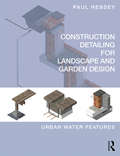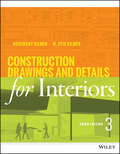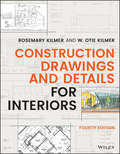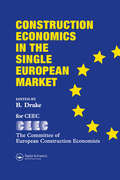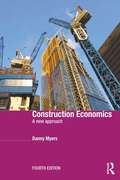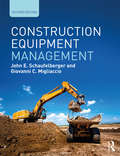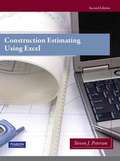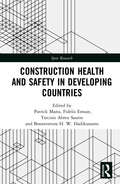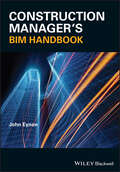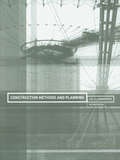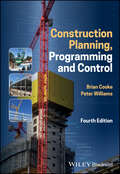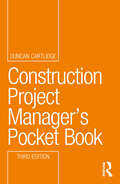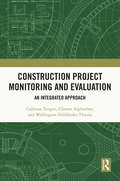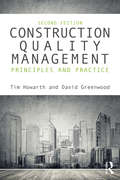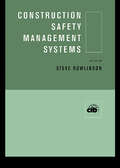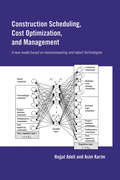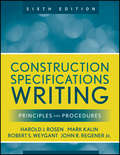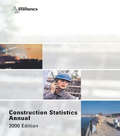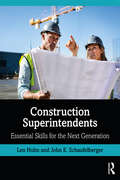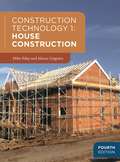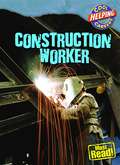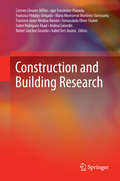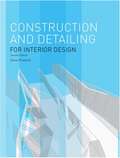- Table View
- List View
Construction Detailing for Landscape and Garden Design: Urban Water Features
by Paul HenseyFollowing on from the author’s previous book, Construction Detailing for Landscape and Garden Design: Surfaces, Steps and Margins, this book, Construction Detailing for Landscape and Garden Design: Urban Water Features, provides clear instruction for the construction of small to medium scale water features. With over 130 black and white CAD designs, Hensey provides guidance on a range of different water features such as drainage, water bowls and containers, walls and edges, structures and crossings, and rills, channels and cascades. This book offers technical references and a general knowledge of the basic principles, materials and techniques needed when engineering with water. This practical guide would be beneficial for garden designers and landscape architects seeking accessible and relatable materials for designing water features.
Construction Drawings and Details for Interiors: Basic Skills
by W. Otie Kilmer Rosemary KilmerConstruction Drawings and Details for Interiors serves as the essential reference for designers preparing interior construction documents, explaining how to do a new construction, remodeling, or installation project. In a highly visual format, the book covers drafting fundamentals and conventions; drawing types, plans, and schedules; and computer-aided design (CAD). With expanded coverage of the preparation and communication of construction documents in digital formats, drawing interior perspectives, and more, the text also serves as an invaluable study reference for the contract documents section of the NCIDQ exam. A new companion Web Site supplies template grids for schedules and contract documents for practice exercises.
Construction Drawings and Details for Interiors: Basic Skills
by W. Otie Kilmer Rosemary KilmerConstruction Drawings and Details for Interiors serves as the essential reference for designers preparing interior construction documents, explaining how to do a new construction, remodeling, or installation project. In a highly visual format, the book covers drafting fundamentals and conventions; drawing types, plans, and schedules; and computer-aided design (CAD). With expanded coverage of the preparation and communication of construction documents in digital formats, drawing interior perspectives, and more, the text also serves as an invaluable study reference for the contract documents section of the NCIDQ exam. A new companion Web Site supplies template grids for schedules and contract documents for practice exercises.?
Construction Drawings and Details for Interiors: Basic Skills
by W. Otie Kilmer Rosemary KilmerCONSTRUCTION DRAWINGS AND DETAILS FOR INTERIORS DISCOVER FOUNDATIONAL CONCEPTS AND THE LATEST DEVELOPMENTS IN INTERIOR CONSTRUCTION DOCUMENTS In the newly revised Fourth Edition of Construction Drawings and Details for Interiors, distinguished interior design professors Rosemary Kilmer and W. Otie Kilmer deliver a comprehensive and practical perspective on the preparation and understanding of construction documents. The authors use a highly visual presentation and offer extensive sample drawings and details, as well as photographs, to show readers the fundamentals of drafting, drawing types, plans, and schedules, and computer-aided design. The Fourth Edition includes new sections on contract administration, field measuring tools, safety and security, and smart systems and controls. A companion website offers PowerPoint lecture slides, an instructor’s manual, activities, test questions, and solutions. New appendices feature examples of interior design projects and common symbols for construction drawings. The book also includes: A thorough introduction to drawing communication, equipment, and classification systems, including information about Building Information Modeling and building certification programs for sustainability A discussion of green building certification programs An exploration of the design process, including concept development, hand sketching, design development, preliminary designs, sketches, and presentations A practical review of contract documents, including specifications, contracts, construction drawings, as-built drawings and demolition plans, and floor plans An in-depth examination of structural, mechanical, and plumbing systems Construction Drawings and Details for Interiors is perfect for interior design students, early-career professionals hoping to improve their understanding of project drawing conventions, or anyone studying for the NCIDQ exam.
Construction Economics in the Single European Market
by B. DrakeConstruction Economics in the Single European Market is an edited selection of papers from the first European Construction Economics Conference. Experts give details on construction costs from many European countries including Denmark, Ireland, France, Sweden, Netherlands, Spain and the UK.
Construction Economics: A New Approach
by Danny MyersConstruction Economics provides students with the principles underlying the relationship between economic theory and the construction industry. Its new approach specifically examines the problems of securing sustainable construction. The new edition has been fully revised to provide an overview of the economy and construction markets since the global financial crisis. As such it examines the challenges of changing government policy, adapting to climate change, adopting BIM, and reducing costs. A new introduction along with new readings, data, examples, glossary items, government strategies, and references, revises this established core text and brings it up to the historic EU referendum. As with previous editions, it retains a tried and tested format: a clear and user-friendly style use of a second colour for emphasis regular summaries of key points a glossary of construction economics extensive use of tables and figures extracts from Construction Management and Economics reviews of useful websites. This invaluable textbook is essential reading across a wide range of disciplines from construction management and civil engineering to architecture, property and surveying.
Construction Equipment Management
by John E. Schaufelberger Giovanni C. MigliaccioThis revised and updated edition of Construction Equipment Management fills a gap on this subject by integrating both conceptual and hands-on quantitative knowledge on construction equipment into a process that facilitates student learning. The first six chapters summarize interdisciplinary concepts that are necessary to ground students' learning on construction equipment management, including both engineering and economics. Each of the next 16 chapters covers a different type of construction equipment and associated methods of use. The final chapter introduces the more advanced concept of operation analysis. This allows the book to be used on numerous courses at different levels to prepare graduates to apply skills on construction equipment when planning for a new project, estimating its costs, and monitoring field operations. Organized around the major categories of construction equipment, including both commercial and heavy civil examples, case studies, and exercises, this textbook will help students develop independence in applying concepts to hands-on scenarios. A companion website provides an instructor manual, solutions, additional examples, lecture slides, figures, and diagrams.
Construction Estimating Using Excel Second Edition
by Steven J. PetersonConstruction Estimating with Excel, Second Edition, introduces readers to the fundamental principles of estimating. Using drawing sets, real-world exercises, and examples, the text offers students critical estimating experience. The book moves step-by-step through the estimating process, discussing the art of estimating, the quantity takeoff, how to put costs to the estimate, and how to finalize the bid. As students progress through the text they are shown how Microsoft Excel can be used to improve the estimating process. Because it introduces spreadsheets as a way of increasing estimating productivity and accuracy, the book can help both beginning and experienced estimators improve their skills.
Construction Health and Safety in Developing Countries (Spon Research)
by Fidelis Emuze Patrick Manu Tarcisio Abreu Saurin Bonaventura H. W. HadikusumoThe global construction sector is infamous for high levels of injuries, accidents and fatalities, and poor health and well-being of its workforce. While this record appears in both developed and developing countries, the situation is worse in developing countries, where major spending on infrastructure development is expected. There is an urgent need to improve construction health and safety (H&S) in developing countries. The improvement calls for the development of context-specific solutions underpinned by research into challenges and related solutions. This edited volume advances the current understanding of construction H&S in developing countries by revealing context-specific issues and challenges that have hitherto not been well explored in the literature, and applying emergent H&S management approaches and practices in developing countries. Coverage includes countries from the regions of sub-Saharan Africa, Latin America, Asia and Europe. This book, which is the first compendium of research into construction H&S issues in developing countries, adds considerable insight into the field and presents innovative solutions to help address poor H&S in construction in developing nations. It is a must read for all construction professionals, researchers and practitioners interested in construction and occupational H&S, safety management, engineering management and development studies.
Construction Manager's BIM Handbook
by John EynonBuilding Information Modelling (BIM) harnesses digital technologies to unlock more efficient methods of designing, creating and maintaining built environment assets, so the Construction Manager's BIM Handbook ensures the reader understands what BIM is, what the UK strategy is and what it means for key roles in the construction team. ensure that all readers understand what BIM and are fully aware of the implications of BIM for them and their organisations provides concise summaries of key aspects of BIM ensure that all readers can begin to adopt this approach in future projects includes industry case studies illustrating the use of BIM on large and small projects
Construction Methods and Planning (Second Edition)
by J. R. Illingworth<p>This new edition of John Illingworth's popular book provides a thorough introduction to the selection of construction methods, their planning and organization on site. Thoroughly revised and updated, Construction Methods and Planning takes a practical, down-to-earth approach and features numerous examples and illustrations taken from real situations and sites. In Part One, the main factors which determine the planning of construction methods - site inspections, the site itself, temporary works, design, cost concepts and selection of plant and methods - are discussed. <p>In Part Two, the application of these tools is presented, covering foundations and basements, in situ and precast concrete structures, steel frames, cladding, internal and external works, waste, methods statements, contract planning control and claims. The author provides an extension of the concept of 'buildability' and new chapters on facade retention and the refurbishment of domestic accommodation.</p>
Construction Planning, Programming and Control
by Peter Williams Brian CookeAn essential introduction to the management of building projects Construction management is a complex discipline with many facets. The essence of construction management is the delivery of construction projects to meet the client’s goals whilst recognising the commercial interests of the many designers, consultants and contractors involved. Balancing the expected quality outcomes, the highest safety standards and time and budget pressures is not an easy task. Therefore, students and practitioners looking to understand the core principles of construction management need an authoritative, accessible and comprehensive text on the subject. Since its first edition in 1998, Construction Planning, Programming and Control has met this need with its practical approach to the management of construction projects. The book covers the principles and practice of project time and cost control and includes key related topics and more. It places the subject matter in the context of the challenges facing the construction industry and explains complex issues in a practical and understandable way. Readers of the fourth edition of Construction Planning, Programming and Control will also find detailed coverage of: Procurement and contracts, supply chain and risk management and health and safety management including CDM 2015 JCT 2016, NEC4; ICC and FIDIC conditions of contract Method statements and the development of safe systems of work Three new major case studies including an in-depth look at HS2 Fully updated content to reflect new thinking with regard to modern methods of construction (MMC), building information modelling (BIM) and the latest planning and cost management software Construction Planning, Programming and Control is an invaluable reference for students of construction management, surveying, civil engineering, and more.
Construction Project Manager’s Pocket Book (Routledge Pocket Books)
by Duncan CartlidgeThe third edition of the Construction Project Manager’s Pocket Book continues to guide and educate readers on the broad range of essential skills required to be a successful construction project manager. The book introduces the generic skills required by any project manager, before tackling the core skills and activities of a construction project manager with direct reference to the RIBA Plan of Work and the OGC Gateway. Key features and coverage in the new edition include:· a step-by-step explanation of construction project management from pre-construction to occupancy,· hard and soft skills, including ethics, leadership, team building,· procurement strategies,· supply chain and contract management,· feasibility studies / development appraisals,· environmental issues,· digital tools and· occupancy activities.The updates in this new edition take account of all regulatory and legislative changes, and also changing market conditions and working trends. This is the ideal concise reference that no project manager, construction manager, architect or quantity surveyor should be without.
Construction Project Monitoring and Evaluation: An Integrated Approach (Routledge Research Collections for Construction in Developing Countries)
by Clinton Aigbavboa Callistus Tengan Wellington Didibhuku ThwalaThis book will provide readers with an in-depth theoretical awareness and practical guidance on the implementation of an effective monitoring and evaluation (M&E) system to ensure construction projects meet approved quality, cost, time and social sustainability objectives. The authors discuss the drivers, challenges, determinants and benefits of effective M&E implementation together with the theories and models underpinning construction project M&E practices. Further, a comparative overview of M&E practices in developed and developing countries is presented to elucidate the best practices. The book first conceptualizes M&E as a five-factor model comprising stakeholder involvement, budgetary allocation and logistics, technical capacity and training, leadership, and communication. It then presents an M&E case study on the Ghanaian construction industry before expanding on the idea of M&E systems as an effective tool for project performance and in optimizing a project’s contribution to society and the environment. The book further provides guidance on M&E practice for construction project managers, investors, professionals, researchers and other stakeholders and is therefore of interest to those in architecture, construction engineering, planning, project management and development studies.
Construction Quality Management: Principles and Practice
by Tim Howarth David GreenwoodQuality management is essential for facilitating the competitiveness of modern day commercial organisations. Excellence in quality management is a requisite for construction organisations who seek to remain competitive and successful. The challenges presented by competitive construction markets and large projects that are dynamic and complex necessitate the adoption and application of quality management approaches. This new edition of Construction Quality Management provides a comprehensive evaluation of quality management systems and tools. Their effectiveness in achieving project objectives is explored, as well as applications in corporate performance enhancement. Both the strategic and operational dimensions of quality assurance are addressed by focusing on providing models of best practice. The reader is supported throughout by concise and clear explanations and with self-assessment questions. Practical case study examples show how various evaluative-based quality management systems and tools have been applied. Subjects covered include: business objectives – the stakeholder satisfaction methodology organisational culture and Health and Safety quality philosophy evaluation of organisational performance continuous quality improvement and development of a learning organisation. New chapters consider the influence of Building Information Modelling (BIM) on quality management. The text should be of interest to construction industry senior managers, practicing professionals and academics. It is also an essential resource for undergraduate and postgraduate students of construction management, project management and business management courses.
Construction Safety Management Systems
by Steve RowlinsonThe construction industry has a distressingly poor safety record, whether measured in absolute terms or alongside other industries. The level of construction safety in a country is influenced by factors such as variations in the labour forces, shifting economies, insurance rates, legal ramifications and the stage of technological development. Yet the problem is a world-wide one, and many of the ways of tackling it can be applied across countries. Effective tools include designing, preplanning, training, management commitment and the development of a safety culture. The introduction and operation of effective safety management systems represents a viable way forwards, but these systems are all too rarely implemented. How can this be done? Should we go back to prescriptive legislation? This book considers these questions by drawing together leading-edge research papers from the proceedings of an international conference conducted by a commission (W099) on Safety and Health on Construction Sites of CIB, the international council of building research organisations.
Construction Scheduling, Cost Optimization and Management
by Hojjat Adeli Asim KarimConstruction Scheduling, Cost Optimization and Management presents a general mathematical formula for the scheduling of construction projects. Using this formula, repetitive and non-repetitive tasks, work continuity considerations, multiple-crew strategies, and the effects of varying job conditions on the performance of a crew can be modelled. This book presents an entirely new approach to the construction scheduling problem. It provides a practical methodology which will be of great benefit to all those involved in construction scheduling and cost optimization, including construction engineers, highway engineers, transportation engineers, contractors and architects. It will also be useful for researchers, and graduates on courses in construction scheduling and planning.
Construction Site for Possible Worlds
by Matthew Poole Robin Mackay Amanda Beech Adam Berg Mat Dryhurst Jeremy Lecomte Anna Longo Anil Bawa-Cavia Patricia Reed Daniel Sacilotto Christine Wertheim Inigo WilkinsPerspectives from philosophy, aesthetics, and art on how to envisage the construction site of possible worlds. Given the highly coercive and heavily surveilled dynamics of the present moment, when the tremendous pressures exerted by capital on contemporary life produces an aggressively normative “official reality,” the question of the construction of other possible worlds is crucial and perhaps more urgent than ever.T his collection brings together different perspectives from the fields of philosophy, aesthetics, and art to discuss the mechanisms through which possible worlds are thought, constructed, and instantiated, forcefully seeking to overcome the contemporary moment's deficit of conceptualizing alternate realities—its apparent fear of imagining possible new and compelling futures—to begin the arduous task of producing the political dynamics necessary for actual construction.Implicit in this dynamic between the imaginary and the possible is the question of how thinking intertwines with both rationality and the inherited contingencies and structures of the world. With no ascertainable ground on which to build, with no confidence in any given that could guarantee our labors, how do we even envisage the construction site(s) of possible worlds, and with what kind of diagrams, tools, and languages can we bring them into being?
Construction Specifications Writing
by Robert S. Weygant Mark Kalin John R. Regener Harold J. RosenUpdated edition of the comprehensive rulebook to the specifier's craftWith this latest update, Construction Specifications Writing, Sixth Edition continues to claim distinction as the foremost text on construction specifications. This mainstay in the field offers comprehensive, practical, and professional guidance to understanding the purposes and processes for preparation of construction specifications.This new edition uses real-world document examples that reflect current writing practices shaped by the well-established principles and requirements of major professional associations, including the American Institute of Architects (AIA), the Engineers Joint Contract Documents Committee (EJCDC), and the Construction Specifications Institute (CSI). Also included are guidelines for correct terminology, product selection, organization of specifications according to recognized CSI formats, and practical techniques for document production. Fully revised throughout, this Sixth Edition includes:Updates to MasterFormat 2004, as well as SectionFormat/PageFormat 2007 and UniformatEnd-of-chapter questions and specification-writing exercisesSamples of the newly updated construction documents from the AIANew chapter on sustainable design and specifications for LEED projectsUpdated information on the role of specifications in Building Information Modeling (BIM)
Construction Statistics Annual, 2000
by Department of the Environment, Transport and the RegionsThis is the first edition of the Construction Statistics Annual presenting a comprehensive set of statistics on the UK construction industry, current as of Summer 2000. In previous years the corresponding information was presented as the Digest of Data for the Construction Industry and as the construction part of Housing and Construction Statistics, but it replaces these and brings the material together in a single volume. This 2000 Edition of the Construction Statistics Annual gives a broad perspective of statistical trends in the construction industry in Great Britain through the last decade together with some international comparisons and features on leading initiatives which may influence the future. This new compendium provides essential, official, in-depth statistical analysis for planners, researchers, economists and construction managers.
Construction Superintendents: Essential Skills for the Next Generation
by John E. Schaufelberger Len HolmConstruction Superintendents: Essential Skills for the Next Generation is the first college-level textbook designed to prepare you to take on a site supervisor role on a complex jobsite. The book covers the responsibilities of superintendents in relation to the jobsite project management team, the project owners, designers, and municipal services. The book outlines the development of the superintendent and his or her role and responsibilities in twenty-first century construction projects. Using examples and case studies of cutting-edge jobsite practices from the use of computer applications to leadership and capital development, this book lays out all the functions of a modern site superintendent in an easy-to-understand format. The book includes: coverage of the full spectrum of tasks and skills required from the pre-construction phase, through start-up, operation and close-out, plus advanced topics for those serious about leading the field real-world case studies, forms, and documentation stored on a companion website chapter summaries, review questions, and exercises to aid both teaching and learning. This book fills in the long-standing need for an academic textbook designed as an applied instructional resource suitable for university and college students enrolled in construction management and construction engineering programmes.
Construction Technology 1: House Construction
by Mike Riley Alison CotgraveConstruction Technology 1: House Construction offers a highly accessible introduction to the key stages of domestic house construction from planning to internal finishes. Its student-friendly layout uses detailed figures, photos and case studies from real-life building sites to aid a practical understanding of construction techniques, providing clear step-by-step guidance in learning the basic principles of low-rise residential construction. This textbook is a vital resource for students in construction, property and architecture, BSc and MSc, including any student taking courses in building surveying, quantity surveying, real estate and construction management, as well as those studying at the HNC/HND level.
Construction Worker (Cool Helping Careers)
by Geoffrey M. HornConstruction Worker: Working in construction means much more than strapping on a tool belt and a hard hat. Careers in the building trades use cutting-edge methods to make the world's tallest skyscrapers, deepest tunnels, biggest stadiums, and most energy-efficient homes. In this exciting book, students follow the progress of a building - and the people responsible for building it - from the plans to the plaster. Learn how to build a career from the ground up!
Construction and Building Research
by Carmen Llinares-Millán Igor Fernández-Plazaola Francisco Hidalgo-Delgado María Montserrat Martínez-Valenzuela Francisco Javier Medina-Ramón Inmaculada Oliver-Faubel Isabel Rodríguez-Abad Andrea Salandin Rafael Sánchez-Grandia Isabel Tort-AusinaMany areas of knowledge converge in the building industry and therefore research in this field necessarily involves an interdisciplinary approach. Effective research requires strong relation between a broad variety of scientific and technological domains and more conventional construction or craft processes, while also considering advanced management processes, where all the main actors permanently interact. This publication takes an interdisciplinary approach grouping various studies on the building industry chosen from among the works presented for the 2nd International Conference on Construction and Building Research. The papers examine aspects of materials and building systems; construction technology; energy and sustainability; construction management; heritage, refurbishment and conservation. The information contained within these pages may be of interest to researchers and practitioners in construction and building activities from the academic sphere, as well as public and private sectors.
Construction and Detailing for Interior Design Second Edition
by Drew PlunkettConstruction and detailing are vital skills for all students studying interior design and architecture. This book is structured to encourage a diversity of techniques, allowing each student the means to find and put into practice the appropriate solution to fabrication issues and also to express their own personal aesthetic. The relation of existing building shells to the construction and detailing of new elements is also explored. Practical tips are given throughout the book, the roles of consultants, manufacturers, suppliers, and fabricators are explained, and theories of modern, sustainable approaches to interior detailing are discussed. The chapters are packed with professional, annotated drawings and explanatory photographs of techniques, materials, and tools. Through these, the principles of sound construction are explained. This second edition includes revised diagrams to increase clarity, more on sustainability, and more on services and lighting.
